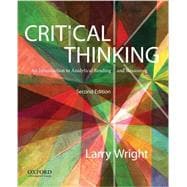
| Chapters 1 and 4-8 open with an Introduction | |
| Each chapter ends with Supplemental Exercises and Answers | |
| Preface | |
| Paraphrasing | |
| The Bare Bones Paraphrase | |
| The Concept of Paraphrase | |
| Reading and Paraphrase | |
| Technique and Vocabulary | |
| Human Understanding | |
| Subtler Issues | |
| Two Principles of Paraphrasing | |
| Things to Keep in Mind | |
| Reading for Structure: Dependency and Subordination | |
| Complexity | |
| Technique and Vocabulary | |
| Useful Patterns | |
| Tricks for Tough Cases | |
| Systematic Features | |
| Trial and Error Exercise | |
| Reading for Reasoning: Paraphrasing Arguments | |
| Reading for a Particular Purpose | |
| Reading for Reasoning | |
| A Shortcut: Schematizing Directly from a Passage | |
| Charitable Schematizing | |
| Analyzing Reasoning | |
| Argument Analysis: Answering Questions | |
| The Purpose of Analysis | |
| The Fundamental Concepts: Questions and Answers | |
| Refining the Apparatus and Exercising Our Skills | |
| Evaluating Arguments: How Good Are the Reasons? | |
| Interim Summary: What We Have Learned So Far | |
| Dealing with Disagreement | |
| Diagnostic Arguments: Reasoning by Explaining | |
| Diagnostic Questions | |
| Diagnostic Concepts | |
| Objects and Resources | |
| Refinements | |
| Diagnostic Investigation | |
| Diagnostic Patterns | |
| Cause and Correlation | |
| Testimony | |
| Sampling | |
| Counting Cases: Induction by Enumeration | |
| Circumstantial Evidence | |
| Further Applications: Prediction and Recommendation | |
| Prediction | |
| Recommendation | |
| Fallacies | |
| Fallacies of Construction | |
| Critical Fallacies | |
| Appendix | |
| Deduction | |
| Introduction | |
| Semantic Conflict | |
| Semantic Evaluation | |
| Deductive Arguments | |
| Structure | |
| Tests and Criteria | |
| Relative Strength | |
| Summary | |
| Glossary of Important Terms | |
| Index | |
| Table of Contents provided by Publisher. All Rights Reserved. |
The New copy of this book will include any supplemental materials advertised. Please check the title of the book to determine if it should include any access cards, study guides, lab manuals, CDs, etc.
The Used, Rental and eBook copies of this book are not guaranteed to include any supplemental materials. Typically, only the book itself is included. This is true even if the title states it includes any access cards, study guides, lab manuals, CDs, etc.